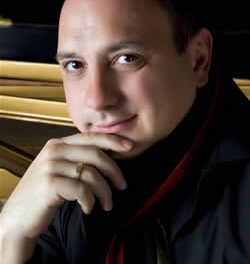Wake Forest University’s Secrest Artists series presented one of its best concerts in recent memory with the Kremerata Baltica, an ensemble of young string-players from the Baltic states (Latvia, Lithuania, and Estonia) and an outstanding percussion player (more later) under the artistic leadership of virtuoso violinist Gidon Kremer, who is of Latvian birth. Despite the camerata bearing his name, Kremer is a modest and soft-spoken musician. A student of the legendary David Oistrakh and winner of many important competitions (including the prestigious Queen Elizabeth Competition in Brussels, Belgium, where I heard many of his performances during my student days), Kremer is one of the planet’s most recorded violinists and has led the life of a musical trail-blazer. This concert was a reminder of why he has remained so important in violin circles and is a testament to his vision of how to inspire subsequent generations of musicians.
The Kremerata Baltica is composed of two dozen 20-somethings, slightly more than half women, and all brilliant on their instruments and possessed of a highly developed ability to concentrate – as evidenced by their performing the entire concert without a conductor. Indeed, the concert included two works for strings alone, the first of which, Béla Bartók’s marvelous Divertimento for Strings, is daunting even with a conductor; yet it was such pleasure looking at the fierce concentration without keeping a distracted eye on an interfering conductor!
The Bartók was played with more than the requisite rubato (rhythmic freedom) and became an unusually expressive and somewhat romantic piece. Structured in three movements, the first is complex, although it follows the general form called sonata form: two contrasting themes whipped up to a major climax and then reintroduced with understatement of the original contrast.
The second movement was written at the time of the death of Bartók’s mother and is reminiscent of a dirge. To the mind of this listener, it is the profoundly moving soul of the entire Divertimento. In contrast, the third movement has always struck me as a popular carnival, with a crier (or auctioneer), a noisy dancing crowd – even a dancing bear, portrayed midway by a slightly tipsy cello solo – and of course, that quiet violin solo moment (a short gentle cadenza) before returning to the frenzy of the festive crowd. This was superb playing – precise attacks, perfect intonation, dramatic dynamics, and expressive rubato: bravi tutti!
Slightly less effective was the transcription of Robert Schumann’s Concerto for Cello and Orchestra for solo violin and strings (plus two tympani in the last movement), and the reason lies more with Schumann than anyone else: the solo writing in the first movement pits the soloist, whether cello or violin, often in a low register, against the agitation of the orchestra, resulting in obscured solo lines. Fortunately, this problem disappears in the second movement where the lovely violin sound of Kremer, playing his 1641 Nicolò Amati (1596–1684) violin, soars above the pizzicato accompaniment, and in the third movement, where the soloist stands out both by rhythmic and register contrast with the accompanying strings.
After intermission we were treated to what might appear to be a smorgasbord of shorter works but was actually a well-chosen menu of works from the group’s recently released CD, De Profundis (from Psalm 130: “From the depths, I cry out…”), described in the program notes as a CD devoted to the response of Art and Music to the cry of anguish at the greed and corruption in some contemporary cultures. The set began with the young (b.1975) Lithuanian female composer Raminta Šerkšnytė’s “De Profundis” (1998); it immediately captured the attention and curiosity of the audience. Insect-like chirpings morphed into cascades of glissandi with rapid tremolos and icy ponticello effects, eventually yielding to a muscular rapid section which, with its many repeated notes, recalled Stravinsky’s Concerto in D for Strings. This complex dramatic 12-minute work, played without a conductor, eventually faded away into the depths whence it had emerged, but not before it had made a powerful impression on the audience.
More familiar, but perhaps equally disturbing, was the ensuing Schubert Minuet in D minor with its sad and reserved demeanor. Two trio sections provided refreshing contrast with the chance to savor the sweetness of Kremer’s tone. Well-known Estonian composer Arvo Pärt composed and dedicated his Passacaglia (2007) to Kremer and his ensemble, including a vibraphone, played by Andrei Pushkarev. As expected in a passacaglia, there is an ostinato or repeated passage, most often in the violin solo, and almost always incorporating the open A-string. The conclusion of the work was especially satisfying.
Departing from the printed program, Kremer and the ensemble next played “Blooming Jasmine,” by Latvian composer and musicologist Georgs Pelécis, in which the vibraphone seems to improvise over a string pizzicato, building in intensity until “lift-off” occurs with a lilting 6/8 rhythm, alternating modally between A minor and C major. This piece was fun, leading the audience to nod, sway and tap their feet.
Two arrangements of works by the innovative Argentine composer Astor Piazzolla closed the concert with flashes of melancholy and virtuosic brilliance. “Melodia in A” provided the melancholy, but the “Fuga” (fugue) gave us the opportunity to observe the brilliant technique of Andrei Pushkarev on the vibes, often playing licks in jazzy unison with Kremer on violin. A warm reception from the enthusiastic audience, sparsely populating the cavernous Wait Chapel, earned a charming rendition of “Dolce Vita” by Italian composer Nino Rota.
Those who missed this exceptional concert might catch it on NPR’s Performance Today, for whom the entire concert was recorded.











